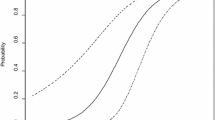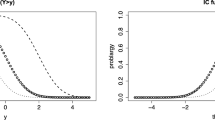Abstract
Test items are often evaluated and compared by contrasting the shapes of their item characteristics curves (ICC's) or surfaces. The current paper develops and applies three general (i.e., nonparametric) comparisons of the shapes of two item characteristic surfaces: (i) proportional latent odds, (ii) uniform relative difficulty, and (iii) item sensitivity. Two items may be compared in these ways while making no assumption about the shapes of item characteristic surfaces for other items, and no assumption about the dimensionality of the latent variable. Also studied is a method for comparing the relative shapes of two item characteristic curves in two examinee populations.
Similar content being viewed by others
References
Andersen, E. B. (1980).Discrete statistical models with social science applications. Amsterdam: North Holland.
Bartholomew, D. J. (1980). Factor analysis for categorical data (with discussion).Journal of the Royal Statistical Society, Series B,42, 293–321.
Birch, M. W. (1964). The detection of partial association, I: the 2 × 2 case.Journal of the Royal Statistical Society, Series B,26, 313–324.
Birnbaum, A. (1968). Some latent trait models and their use in inferring an examinee's ability (Part 5). In F. Lord & M. Novick (Eds.),Statistical theories of mental test scores (pp. 397–479). Reading, MA: Addison-Wesley.
Bock, D., & Lieberman, M. (1970). Fitting a response model forn dichotomously scored items.Psychometrika, 35, 179–197.
Cressie, N., & Holland, P. W. (1983). Characterizing the manifest probabilities of latent trait models.Psychometrika, 48, 129–141.
Dawid, A. P. (1979). Conditional independence in statistical theory (with discussion).Journal of the Royal Statistical Society, Series B,41, 1–31.
Feller, W. (1971).An introduction to probability theory and its applications, Volume II (2nd ed.). New York: John Wiley.
Fischer, G. (1973). The linear logistic test model as an instrument in educational research.Acta Psychologica, 37, 359–374.
Goldstein, H. (1980). Dimensionality, bias, independence and measurement scale problems in latent test score models.British Journal of Mathematical and Statistical Psychology, 33, 234–246.
Goodman, L. (1974). Exploratory latent structure analysis using both identifiable and unidentifiable models.Biometrika, 61, 215–231.
Holland, P. W. (1981). When are item response models consistent with observed data?Psychometrika, 46, 79–92.
Holland, P. W. and Rosenbaum, P. R. (1986) Conditional association and unidimensionality in monotone latent variable models.Annals of Statistics, 14, 1523–1543.
Lazarsfeld, P., & Henry, N. (1968).Latent structure analysis. New York: Houghton Mifflin.
Lehmann, E. L. (1955). Ordered families of distributions.Annals of Mathematical Statistics, 26, 399–419.
Lehmann, E. L. (1959).Testing statistical hypotheses. New York: John Wiley.
Lord, F. M. (1977). A study of item bias, using item characteristic curve theory. In Y. H. Poortinga (Ed.),Basic Problems in Cross-Cultural Psychology (pp. 19–29). Amsterdam: Swets and Zeitlinger.
Lord, F. (1980).Applications of item response theory to practical testing problems. Hillsdale, NJ: Lawrence Erlbaum.
Mantel, N., & Haenszel, W. (1959). Statistical aspects of the retrospective study of disease.Journal of the National Cancer Institute, 22, 719–748.
Mokken, R. J., & Lewis, C. (1982). A nonparametric approach to the analysis of dichotomous item responses.Applied Psychological Measurement, 6, 417–430.
Rasch, G. (1960).Probabilistic models for some intelligence and attainment tests. Copenhagen: Neilson and Lydiche.
Rasch, G. (1966). An item analysis which takes individual differences into account.British Journal of Mathematical and Statistical Psychology, 19, 49–57.
Rosenbaum, P. R. (1984). Testing the conditional independence and monotonicity assumptions of item response theory.Psychometrika, 49, 425–435.
Rosenbaum, P. R. (1985). Comparing distributions of item responses for two groups.British Journal of Mathematical and Statistical Psychology, 38, 206–215.
Tjur, T. (1982). A connection between Rasch's item analysis model and a multiplicative Poisson model.Scandinavian Journal of Statistics, 9, 23–30.
Traub, R. E., & Wolfe, R. G. (1981). Latent trait theories and the assessment of educational achievement.Review of Research in Education, 9, 377–435.
Author information
Authors and Affiliations
Additional information
The author is grateful to Paul Holland, Robert Mislevy, Tue Tjur, Rebecca Zwick, the editor and reviewers for valuable comments on the subject of this paper, to Mari A. Pearlman for advice on the pairing of items in the examples, and to Dorothy Thayer for assistance with computing.
Rights and permissions
About this article
Cite this article
Rosenbaum, P.R. Comparing item characteristic curves. Psychometrika 52, 217–233 (1987). https://doi.org/10.1007/BF02294236
Received:
Revised:
Issue Date:
DOI: https://doi.org/10.1007/BF02294236




